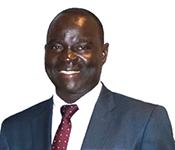
Hostos assistant mathematics professor Moise Koffi has spent much of the last decade and a half ensuring young people in the South Bronx have firm roots in STEM fields. He hails from Ivory Coast, where he worked in the private sector prior to moving to the U.S. and transitioning into a career in academia. An alumnus of the City College of New York and the Graduate Center, Professor Koffi joined the Hostos family in 2003 as an instructor for Proyecto Access, a STEM program for middle and high school students from underserved communities. He has since mentored countless STEM leaders of tomorrow as a professor and current director of Proyecto Access, STEP, and CSTEP at Hostos.
Learn more about Professor Moise Koffi in this edition of 10 Questions With…
What brought you to Hostos?
I started here in 2003. I was referred to Hostos by one of my classmates when I was a graduate student at City College, and he told me about the Proyecto Access summer program as a job opportunity. I taught secondary school students for three summers, and then I became the director of the program.
What impact have you seen Proyecto Access have on students during your tenure with the program?
The program has had a tremendous impact on the community. We have served more than 5,000 students in the community since the inception of the program, and it has expanded to include college students. In 2011, we wrote a grant to implement the Collegiate Science and Technology Entry Program (CSTEP) to serve college students and provide them with tutorial services in gateway courses in STEM, internships and research opportunities, career services, and participation in conferences, in a sense, to smooth their transition into a four-year institution.
What do you enjoy most about teaching at Hostos?
What I enjoy most about teaching at Hostos is first, you have to understand the community that our students are living in; many of them have a fear of mathematics. So, it is interesting to help them overcome their fear. Also, interesting to help someone understand the issues that they’re facing—the social forces against their success. It’s like providing a life transformation to our youth to become STEM professionals of tomorrow.
What has been your greatest professional accomplishment so far?
I have published my work in international journals. For instance, I’ve published my research in the International Journal of Heat and Mass Transfer and the Journal of Heat Transfer, which are ranked among the top engineering journals in my field. And I have written grants. I am really proud to have implemented the CSTEP program here at Hostos for the first time. I also mentor students. My students have won awards at statewide conferences. These are accomplishments that make me proud and make me enjoy my career.
What are you researching now?
I investigate the metabolism of elephants.
What about your field excites you?
What excites me? My research. I like conducting research, attending conferences. And trying to be part of the science community and also giving back to the students as I teach them as an educator.
What do you think you would be doing for a living if you weren’t teaching?
I worked as an engineer in the private industry for many years, so this is another profession that I could be doing, or maybe writing books.
How did you become interested in engineering in general?
When I was in secondary school, mathematics was one of my favorite topics; I enjoyed it, and I was very good at it. In my country, when you have potential in mathematics and the sciences, you have the option to explore engineering. So, I was advised and I became interested in engineering because of my strong science and math background.
What advice do you have for Hostos students and prospective students who are interested in pursuing a career in STEM?
At Hostos, we have numerous resources, such as internship opportunities and research opportunities. My advice to Hostos students is to take advantage of these resources if you want to major in STEM. For instance, I want our STEM students to have at least one internship experience or research experience before they transfer to a four-year college because these internships provide skills that they will not get in the classroom. It’s good to go into the field and explore. Not only does it help them better understand their STEM courses, but it helps them have a connection with the workplace.
Also, studying STEM is time-consuming, so it needs a lot of practice and a lot of hard work. They need to work really hard and they need to have a passion for it. When you like it, you do it better.
What is one of the most valuable pieces of advice that you’ve ever received?
My inspiration comes from my Ph.D. mentor; his name is Professor Latif Jiji. He said work really hard and never give up. This really helped me because life can be complicated, but never give up.